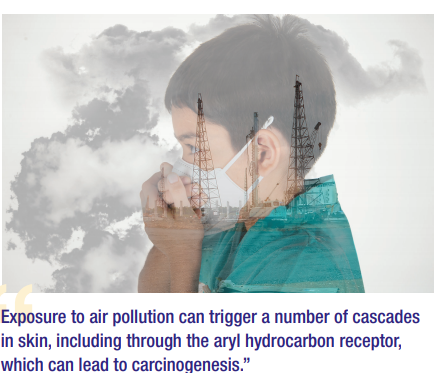“The skin is our largest organ and is the primary interface with the environment. So, I would argue that dermatologists should be a large part of the conversation about how climate is impacting health,” said Eva R. Parker, MD, FAAD.

There are many ways in which climate change impacts skin cancer risk and incidence, she noted. “One is heat. As carbon dioxide emissions increase, CO2 concentrations in our atmosphere have increased and are trapping massive amounts of heat. In case someone hasn’t noticed, we are having repeated heat waves, especially on the West Coast,” she said. “Heat leads to human behavior changes. We tend to shed clothing, making our skin more exposed to UV light.”
“Another is air pollution,” Dr. Parker continued. “CO2 emissions and greenhouse gas emissions have the same root cause, which is burning fossil fuels. There is a whole host of non-greenhouse gas emissions that also result from burning fossil fuels, including from industry, factories, and cars. Those kinds of pollutants include things like particulate matter, which is noxious for our skin. In fact, particulate matter is so tiny that it is absorbed by our skin through hair follicles and sweat glands and directly through the epidermis.”
Exposure to air pollution can trigger a number of cascades in skin, including through the aryl hydrocarbon receptor, which can lead to carcinogenesis.
“Interestingly, these mechanisms are synergistic with UV light. When you combine UV and pollution, you get a greater risk of carcinogenesis of the skin,” Dr. Parker said. “When you have sunlight and air pollution and heat-trapping, you get greater production of noxious tertiary pollutants, like ozone.”
In skin, ozone acts to stimulate reactive oxygen species, which can further promote carcinogenesis, Dr. Parker noted.

The stratospheric ozone is the layer of the earth’s atmosphere charged with deflecting much of the UV radiation that would otherwise reach the earth’s surface and cause harm. Unfortunately, this protective layer has developed holes, which, according to Dr. Parker, is due to chemicals, including chlorofluorocarbons (CFCs), which were developed by DuPont in the 1930s and used widely as refrigerants and in industry.
CFCs last long in the atmosphere and act as greenhouse gases in a way that is much more potent than carbon dioxide, according to Dr. Parker.
“When conditions are right, especially over the Poles and, particularly, over Antarctica, these compounds cleave the ozone in the stratospheric layer and break it down. The result is the emergence of these large holes over the Poles that appear seasonally,” Dr. Parker said. “Consequently, we have had a marked increase in skin cancer rates globally and this is especially problematic for places like Australia and New Zealand whose geographic proximity to those large ozone holes in the South Pole is substantial.”
This only scratches the surface of how climate change can impact skin cancer. The impact in the United States is not universal and is complex. Some regions of the country are more vulnerable than others. For example, wildfires in the West, caused by excessive heat and drought, impact air quality across the U.S.
Interestingly, climate change is disproportionately affecting Black, Hispanic, and other disadvantaged minority populations, Dr. Parker noted. Many in those populations tend to live in “urban heat islands,” near factories in cities full of concrete and asphalt but few trees.
There are ways in which dermatologists can get involved from a sustainability standpoint. “The American Academy of Dermatology (AAD) has a number of resources, including our Expert Resource Group on Climate and Environmental Affairs,” Dr. Parker said. “Another easy step is to make our offices more sustainable by using the My Green Doctor tool, which is free to AAD members.”
By Lisette Hilton
Reference
Parker ER. The influence of climate change on skin cancer incidence—a review of the evidence. Int J Womens Dermatol. 2020 Jul 17;7(1):17-27. doi: 10.1016/j.ijwd.2020.07.003. PMID: 33537393; PMCID: PMC7838246.
Editor’s Note: Dr. Parker also presented on the topics climate science and the health effects from climate change and climate change and dermatology at a Texas Dermatological Society meeting earlier this year.
Disclosure
Dr. Parker reported no relevant disclosures.


